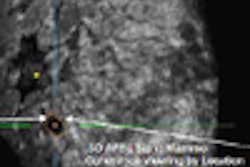Radiation oncologist Dr. Gordon Ray and his colleagues at the Palo Alto Medical Foundation (PAMF) in Palo Alto, CA, see between 500 and 600 cancer patients a year. Their organization’s oncology practice is a large one, and makes use of two linear accelerators and a simulator.
But beyond the high patient volume, the organization's radiation oncology area is busy undergoing a workflow transformation as Ray's group juggles an increasingly large load of digital images, both self-generated and by their counterparts in the imaging department.
"Image management in general is really going to be one of the major challenges for radiation oncology departments in the next three to five years," said Ray, chairman of the department of radiation oncology at PAMF. "It’s a huge, huge new arena in which many of the (radiation oncology-based) manufacturers don’t have real expertise, because they’ve been focused on linear accelerators and hardware."
While the large PACS vendors have sophisticated, elaborate systems with high levels of specific image-viewing functionality, the discipline of radiation oncology has very specific needs. As a result, PACS for radiation oncology remains in something of an in-between place: juggling images from the standard PACS networks with images produced by their own treatment planning systems.
"While a PACS can streamline workflow and improve patient care, the challenge is that the standard radiology PACS systems don’t meet the need for integration" present in radiation oncology departments," Ray said. "A radiation oncology PACS has to be seamlessly integrated with the medical record and treatment planning."
The challenge that PACS vendors face is providing radiation oncologists with the kind of integration Ray described. PACS for radiation oncology needs to be fluid and iterative rather than based on one-time tasks, and, as a result, is a fundamentally tall order.
Challenges to a smaller market
There are a number of hurdles that need to be jumped before that seamless integration takes places. One factor is the size and configuration of the radiation oncology vendor market.
"This is a small, specialized market dominated by just a few vendors, noted Atlanta-based Rick Belter, a sales specialist for Nucletron of Veenendaal, the Netherlands. "There are 2,800 radiation oncology departments in (the U.S.), and four, or possibly five, vendors, including a couple of dominant ones." As a result, the market-driven push for integration is not as strong as it might be, though the functional need is there among radiation oncologists, Belter believes.
At the same time, the increased digitization of their work is nonetheless increasingly pulling radiation oncologists into the vortex of workflow and storage issues that have come with the implementation of digital image systems.
"Since most radiation oncology departments have their own CT (scanners), images are being created within the department, and at the same time, diagnostic PACS images are coming to radiation oncology from (the radiology department)," Belter said. It makes for a challenging situation, as there is no naturally occurring integration process involved, he added. Radiation oncologists want both kinds of images for diagnostic information and treatment planning.
Making do -- and making improvements
Despite the challenges of making the connection between PACS and radiation oncology, advances in current PACS technology have been positive for patient care and physician practice, said Dr. James McGee, director of oncology services at OSF Health Care System in Peoria, IL. McGee's department sees over 2,000 patients a year for radiation treatment.
"We use our PACS system in the hospital to have our diagnostic images right in front of us at the time we’re doing treatment planning. Previously, it was a matter of looking at the films and hoping you could remember what it looked like when you left radiology and started designing your fields," McGee said.
Whatever the concomitant storage and integration challenges involved, being able to view accurate digital images in real time while planning treatment marks a huge step forward in clinical practice for radiation oncologists, he pointed out.
The treatment of cervical cancer is one example. The emerging standard of care requires contouring based on MR images, McGee said. "So that really mandates that one be able to look at all the MRI diagnostic studies at the time one is planning (treatment)...and that's both with implant radiation and external beam," he said.
And since the implant itself may cause some degradation of the image taken for treatment planning, you really need all those images available at the time you’re dosing the patient -- and it has to be very, very specific information. "That's probably not too different from other specialties, except that we use them very intensively," he added.
While they wait for that "perfect" PACS to come along, radiation oncologists have high expectations of their colleagues in radiology. McGee acknowledged that he and his colleagues are "more demanding of our radiologists, in terms of specifying what sequences they need to do on things like MRI scans to give us the information we need, and also in giving us specific information that we need to design our fields with," he said.
The advent of detailed, conformal dose planning means that radiation oncologists are spending more than a few minutes on designing their treatment regimens. The process of requesting images from radiologists has become very specific.
"We used to do a patient plan in five minutes," McGee said. "(Now) the whole process of talking to the radiologist and entering the information is one to two hours. Now we’re able to shape our radiation and deliver it much more precisely than before."
While collaboration is always a plus, radiation oncology still requires a more flexible PACS, said Edwin Nell, a systems marketing manager at Varian Medical Systems of Palo Alto, CA. "While a radiologist would look at a study one time and make a decision based on that image, an oncologist would be using these images multiple times over the course of treatment, as reference, as baseline images, and so forth," Nell noted. "So (images) are constantly being reused to make some sort of determination about the course of treatment."
"(Traditional) PACS don’t handle the time-based situation of images changing over time, and there's no parent-child relationship. You need the history of a treatment plan, which is not supported in traditional PACS systems," Nell said.
Peering into the future
Will vendors -- from either side of this digital divide -- step up to the plate and begin to deliver the solutions that radiation oncologists need?
Some vendors are indeed working with radiation oncology departments to bridge the gap between images and data. Hansen Chen, the senior medical physicist in the radiation therapy and oncology department at ChristianaCare Health System in Newark, DE, is collaborating with Siemens Medical Solutions of Malvern, PA, to better integrate DICOM-RT objects generated by Siemens' radiation therapy equipment with the hospital's radiology PACS network, which is provided by another vendor.
Siemens is crafting a comprehensive viewing and storage solution for the department that that will allow Chen and his colleagues to work more smoothly with the range of images and objects they are producing and acquiring, he said. This is particularly important because the department began producing images via its image-guided radiation therapy machine about two years ago, he added.
Being able to manage images, objects, and data is important for workflow reasons, as well as staffing and economics. "We are essentially creating our own internal archive, our own PACS," Chen said. "The radiation therapy department doesn't want to manage all these images, because it means hiring staff and infrastructure."
Similarly, Ray is currently collaborating with Varian to develop a rad onc's dream PACS network. "The radiology PACS is really just a viewing system. As I look at it, what (radiation oncology) really need(s) is an image-enabled charting system that allows the images to be cleanly displayed alongside clinical data, to improve workflow and patient care," Ray explained. "You look at images when consulting, when doing treatment planning, and our goal is to move beyond that -- we’re setting up a multimodality clinic, and we will need to work with digitized images across the spectrum of care. That changes the workflow." If the current project at Varian pans out, it could optimize clinical workflow across radiation oncology care sites nationwide, he said.
Rather than starting from scratch to custom-build a system for radiation oncology, other vendors are looking to create broader, enterprise-wide PACS in order to eliminate the "islands of information" proliferating across medical specialties, said Robert Mayer, global segment manager for radiology solutions at the Integrated IT Solutions division of GE Healthcare of Chalfont St. Giles, U.K.
"I truly believe that we will end up with single storage components within patient care organizations, and that the right model is to 'PACS-enable' specific solutions, such as radiation therapy and radiation oncology solutions," Mayer said.
How to resolve the problem of radiation therapy/oncology departments producing DICOM objects that current radiology PACS software can’t work with? "They’re moving towards some form of DICOM IHE, where they would create a structured report," Mayer explained. "And once the PACS vendors achieve the necessary technical compatibility, they will absorb these radiation therapy/oncology reports as single data objects," with the DICOM objects embedded in them, he said.
Meanwhile, Mayer said, though GE has not yet begun formal development in this area, he believed the company would, within 18-24 months, have the capability to support enterprise-wide PACS networks that would meet the needs of radiation oncology departments.
Ray agreed that it's a time of intensive development and progress that will result in greater clinical effectiveness in the radiation therapy/oncology arena. "The next two to three years will all be about better integrating and interpreting images and more closely aligning the dataset in a more seamless way," Ray said.
By Mark HaglandAuntMinnie.com contributing writer
August 9, 2007
Related Reading
Radiologists call on PACS vendors to improve 3D imaging integration, July 25, 2007
Radiologists, clinicians perceive PACS success differently, June 27, 2007
When the OR and radiology collide, workflow solutions are needed, June 8, 2007
Copyright © 2007 AuntMinnie.com



















